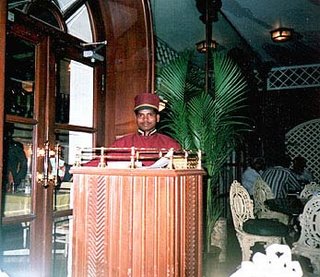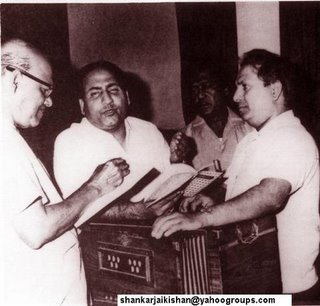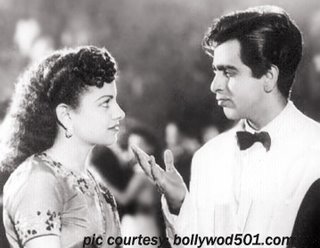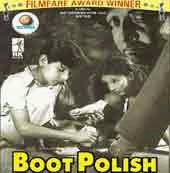SHANKAR JAIKISHAN TRIVIA FACTS
By A. Acharker
(member of SJ grp :http://groups.yahoo.com/group/shankarjaikishan)
Last weekend in San Jose (SJ), there was a Grand Prix car race in which celebrity Paul Newman (now 80!) participated. The intersting trivia was that the SJ Grand Prix was won by a person named Sebastian!!!
As I had mentioned before, I live in the city of "SJ" (San Jose) in California USA. My high school was SJ (St Joseph's) in Mumbai. SJ graced the Golden Jubilee of my school in 1967 and Sebastian was instrumental in the same.
This prompted me to think about some of the trivia facts about SJ. Each one of these facts could spawn a thread!
1) Asrani can be seen in the first row of chorus in the song, "Ab kahan jayen hum.." in'Ujala.' He also appears in the movie, "Hare Kaanch ki Chudiyan" but we always think of his debut as "Umang"
2) Subhash Ghai lip-synched on several songs partially in 'Umang' but also "sang" the Rafi song completely in the same film, "Baabul kaun ghadi.."
3) Jaya Bhaduri never had the opportunity to sing a song of SJ. However, Jaya acted on the Asli Naqli song "Tujhe jeevan ki dor se" in Guddi with Dharmendra.
4) Amitabh never had the opportunity to sing a song of SJ. BUt Shankar's favorite dummy words "Tandana Tandana.." became a mukhda of his (LP) song where he mimicked Mehmood."Tandana Tandana.." words were first heard in "MayurPankh" and later in "Gumnaam"
5) "Gumnaam" becomes the only film ever that had music influenced by a Hollywood film and that influenced a Hollywood film in return! The two films are "Charade" and "Ghost World" respectively.
6) "Gumnaam" had Mehmood singing "Bhai Battoor.." which later became a song in Padosan.Mehmood also sang "Lal ghoda.." in "Shatranj" which became a full-fledged song in "Kunwaara Baap"
7) "Ram Teri.." song "Sun Sayba.." is influenced by "I love you.." from "Sangam"
8) The tune for "Jaane kahan gaye woh din..." was first heard in background music of "Jis Desh mein..."
9) The Goan tune for "Na maagoo sona chandi.." was first heard in background music of "Awara." It was played just before the song "Dum bhar jo udhar moonh phere"
10) "Jaaon kahan bata ai dil" from "Chhoti Bahen" was influenced by the title music of "New Delhi"
11) "Mora nadaan balma" from "Ujala" was influenced by the title music of "Mayurpankh"
12) "Kisiki muskuraton pe" from "Anari" was influenced by the background music of "Shree 420"
13) "Sambhal ke karna.." tune from "Ek Phool Char Kaante" was used in the background of "Golmaal" by RDB very often. SDB also used a tune from the same movie in "Chupke Chupke"
14) Besides Rajendra Kishan who wrote lyrics for "College Girl," SJ also utilized the service of lyricist Deepak in "Boot Polish" when Shailendra was alive.
15) Though Shailendra was associated with Shanker, it was Hasrat Jaipuri who wrote the lyrics in Shanker's solo venture, "Street Singer" produced by Chandrashekhar. Hasrat Jaipuri also appears in the movie. Shanker did so under the pseudonym, Suraj. The other movie he composed music for, under this name was the Marathi, "Tee Mee Navhech."
16) Jaikishan appears in "Main Sundar Hoon" with Anand Bakshi, his only film with SJ.
17) Gulshan Bawra appears in two songs of SJ in "Beimaan" and "Jungle Mein Mangal." He did not write lyrics for these movies but wrote lyrics for other SJ films like "Chori Chori," (new) "Jaane Anjaane," and "Aan Baan."
18) Neeraj acted on the song "Paise ki Pehchan.." in the film "Pehchan" and also wrote the lyrics for the same.
19) Neeraj and Hasrat Jaipuri teamed together for SJ in the film "Dil Daulat Duniya" for a song. Later they also wrote all the lyrics for all songs of "Jungle mein Mangal." The results weren't great. I like the song "Tum Kitni khoobsoorat" They also wrote lyrics for Usha Khanna's "Paani mein jale mera gora badan.." in "Munimji" (1973).
20) "Kismat Ka Khel" had a Lata song with dummy words that sounded like "Echo Echo.." Years later, Shanker used similar words in a song in "Naari" which happened to be the only SJ song sung by Yesudas (with Amit Kumar), "Neeche zameen, upar gagan.."
21) Director Prayaag Raaj yelled "Yahoo.." in the "Junglee" song whereas Shanker was responsible for "Ayaya Sukoo Sukoo.." Prayag Raaj later acted in "Bombay Talkie and also directed "Insaniyat" starring Shashi Kapoor and Madhu.
22) Dattaram lip-synched for the song, "Tum mere pyar ki.." from "Bombay Talkie" acting as a playback singer.
23) SJ were responsible for Usha Iyer's first film songs in "Bombay Talkie" and this was about two years before her success in "Hare Rama Hare Krishna."
24) Ustad Ali Akbar Khan played the sarod in "Suno Chhotisi Gudiya ki.." Pannalal Ghosh played the flute in "Main piya teri.."Hazara Singh played the electric guitar in "Tera teer.."Manohari played the saxophone in "bedardi Balma.."
25) Bappi Lahiri's father Aparesh Lahiri sang an SJ song in "Badshah" (I have not heard this one.)
26) Famous classical singer Bhimsen Joshi sang a jugalbandi in "Basant Bahar" with Manna Dey.
27) Anuradha Paudwal, Alka Yagnik, Chandrani Mukerjee, Sharda, Dilraj Kaur all sang "Ari o sakhi.." for SJ together in "Kaanch ki Deewar." Lead Stars Sanjeev Kumar, Smita Patil and Shanker all died within months after the release of the movie.
28) "Gaya Bachpan.." from "Ankhon Ankhon Mein" was the last song recorded by Jaikishan.
29) The movie "Preetam" has title music that is the same as that of "Mere Sanam" of OP Nayyar. The movie was released just a few months after Jaikishan died. Does anyone have an idea why? The producer of the movie was Bhappi Sonie.
30) The first SJ movie without a Lata song was "Boot Polish." It was also the only movie of SJ with RK without a Mukesh song!
31) Aarti Mukerjee sang a song for SJ in "Boy Friend" in 1960 and the next SJ song that she sang was in 1974 for "Neelma."
32) Joy Mukerjee had SJ music only in two movies: "Love in Tokyo" & "Love in Bombay"
33) The first RK Films movie to win a Filmfare Award was 'Mera Naam Joker," the last SJ movie of SJ with Raj Kapoor was the hero!
34) Omprakash, the actor, directed the Raj Kapoor starrer "Kanhaiyya" produced by his brother, Pachhi. Pachhi also produced "Around the World" and "International Crook" in which Omprakash got to sing songs on screen!
35) SJ had the privilege of composing music for the only complete original color film starring Madhubala, "Jwala."
36) The first color film for which SJ composed music was "MayurPankh" starring Kishore Sahu.
37) SJ composed music for several films shot on foreign locations and provided music to suit the mood: Sangam, Pyar Mohabat, Naina, Dharti, An Evening in Paris, Love in Tokyo, International Crook, Singapore, Around the World, Saazish.. International Crook was shot in Alaska.
38) SJ composed music for the first 70mm film in India: "Around the World."
39) "Dream Girl is coming" was what the posters said when "Sapnon Ka Saudagar" was about to release. SJ were amongst those who chose her for the role.
40) The last SJ film to have multiple songs played on Binaca Geetmala was "Sanyasi."
41) "Krishna Krishna" is the only mythological film for which SJ composed music.
42) Shammi Kapoor heads the list of SJ leading men. Rajendra Kumar comes a distant second. Vyjayanthimala heads the list of SJ leading women.
43) The only Dev Anand song sung by Kishore Kumar for SJ was "Dooriyan Nazdikiyan" in "Duniya."
44) "Zindagi Ek Safar hai suhana.." from "Andaz" has three voice versions: Kishore Kumar, Asha Bhonsale and Mohd Rafi.
45) Hemant Kumar's daughter Rano Mukerjee sang a few songs for SJ in the mid seventies in "Saazish," "Resham Ki Dori," and "International Crook." The song that she sang for
"International Crook" was not used in that film but instead found its way in the film, "Eent ka Jawab Patthar." The song was "Poochha jo pyar kya hai.." with Kishore Kumar.
46) The film "Dur Nahin Manzil" was first assigned to Roshan who died. Later SJ were signed for the same and Jaikishan died during its making. Suman Kalyanpur had sung the title song for Roshan. She also sang for SJ in the film: "Bezuban dil shor na.." The heroine was originally Nutan. She had acted in producer Hari Valia's earlier venture, "Laatsaab" but due to a misunderstanding with Sanjeev Kumar, she stepped out and was replaced by Bindu's sister (and Laxmikant's sister-in-law) Reshma.
47) Mohd Rafi sang two non-film English songs for SJ. They were uploaded on the site earlier.
48) SJ's first HMV LP Album had a picture of them with their two 1959 White Impala cars with fins and also their Filmfare awards.
49) HMV had released a Lata LP in which all songs were composed by SJ. The songs included: "Bol ri Kathputli.." "Mohabat ki Daastan.." "Jeevan ke do rahe pe khade.."
50) Anuradha Paudwal did a cover version of Lata songs for SJ for T-Series. Later, HMV released a cassette with almost the same original songs.
51) Almost all SJ films were from HMV. SJ's first movie album to be released for Polydor (now Music India) was "Love in Bombay." "Archana" was also on Polydor. "Chorni" was with INRECO.
52) There is a chowk (street junction) called "Shanker Jaikishan Chowk" close to Eros Theatre in Mumbai.
53) Some of the lead dual roles in SJ films:Shararat Kishore Kumar An Evening in Paris Sharmila TagoreBhai Bhai Sunil DuttChhote Sarkar Shammi KapoorMahfil SadhanaAtmaram Shatrughan SinhaYakeen DharmendraGaram Khoon Vinod Khanna
54)Some non Hindi words in SJ songs:Kali Ghata: Il ya Belle...Shree 420: Rammaiyya vastavayya...Singapore: Rasa Sayang re...Junglee: Yahoo!...Sangam: I love you...Love in Tokyo: Sayonara...Pyar Mohabat: Hooray Hooray.. Aman: Puru sato Japan..Shatranj: Badkamma Ikkad po tora..Garam Khoon: Penelope...Eent Ka jawab Patthar: Comment allez vous...
55) SJ may have the highest mukhdas of their songs later converted to movie titles:"Lal Dupatta malmal ka""Raja ki aayegi baraat""Tumse achha kaun hai""Kashmir ki Kali""Aa gale lag jaa""Aan Milo Sajna""Tumko na bhool payenge""Kuch kuch hota hai""Nain mile chain kahan""Aaja Sanam""Aa ab laut chale""Phir bhi dil hai Hindustani""Main Ashiq hoon baharon ka""Mujhe meri biwisi bachao""Kaun hai jo sapnon mein aaya""Bol Radha Bol""Buddha Mil Gaya""Dil ke Jharonke mein""Gustakhi Maaf"
56) Lata Mangeshkar and Jaikishan were both born in 1929. Shanker was elder.
57) Manmohan, Deven Verma, Satish Wagle were Jaikishan's very close friends and they met regularly at Gaylord's near Churchgate, Mumbai. Manmohan can be seen in key roles in Satish Wagle's "Pyar Hi Pyar" and "Yaar Mera."
58) SJ utilized Rafi and Mukesh for all three Kapoor brothers:Raj Kapoor had a Rafi song in "Ek Dil Sau Afsane" & "Mera Naam Joker" Shammi Kapoor had a Mukesh song in "Ujala" and "Singapore" Mukesh sang one song for Shashi Kapoor in "Insaniyat"
59) SJ had Mahendra Kapoor playback for Dev Anand in "Roop Ki Rani CHoron Ka Raja" (Yes, I have the video of the movie. It's a fact!)
60) Sushama Shreshta was introduced by SJ in "Andaz" and also sang in "Seema" She later sang as Poornima. Ramesh Sippy and Salim-Javed of "Sholay" fame also started with "Andaz."
61) SJ were signed for the following movies originally: "Bobby," "Seeta Aur Geeta"I remember clearly having seen ads to that effect in Screen. Unfortunately, I did not save those issues.
62) Guru Dutt had one only movie as a lead actor with SJ: "Sanjh aur Savera" But his younger brother had a close relationship with SJ: Shikar, Chanda aur Bijli, Umang, Yaar Mera and Resham Ki Dori.
63) Besides Dattaram and Sebastian, SJ also had other assistants like Sonny Castellino (Awara), Dheeraj (Sanyasi), Enoch Daniels (Kaanch Ki Deewar, Gori, Krishna Krishna)
64) SJ composed background music for a documentary at the peak of their career in 1967. The docmentary was "Everest" and narrated the expedition by Nawang Gombu's team. Incidentally, this team included my cousin's husband, Dr Telang as a team doctor.
65) Shatrughan Sinha sang "Mera Joota hai japani" at a function in 1972 under Shanker'ssupervision.
67) Sudha Malhotra sang the "Chori Chori" duets with Manna Dey during the 1957 function for 1956 FF awards.
68) Shanker composed Indian classical tunes for AIR Delhi in the late seventies.
69) Shanker liked Hitchcock film music. I will post an article on that.
Labels: Abhay, Bollywood, composer, film, Hasrat, Hindi, Jaikishan, Lata, music, Rafi, Raj kapoor, Shailendra, shammi, Shankar, Shankar jaikishan






















